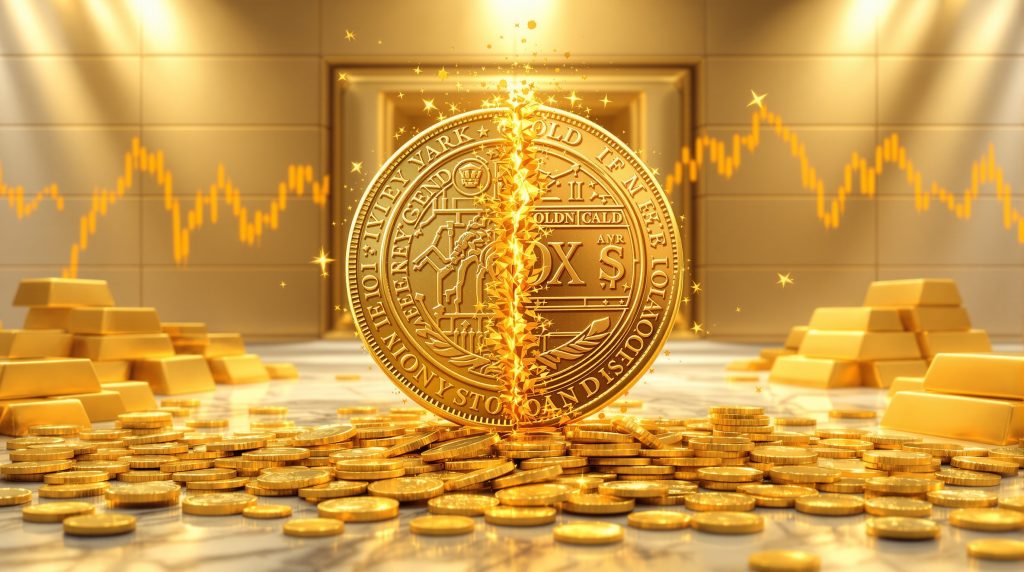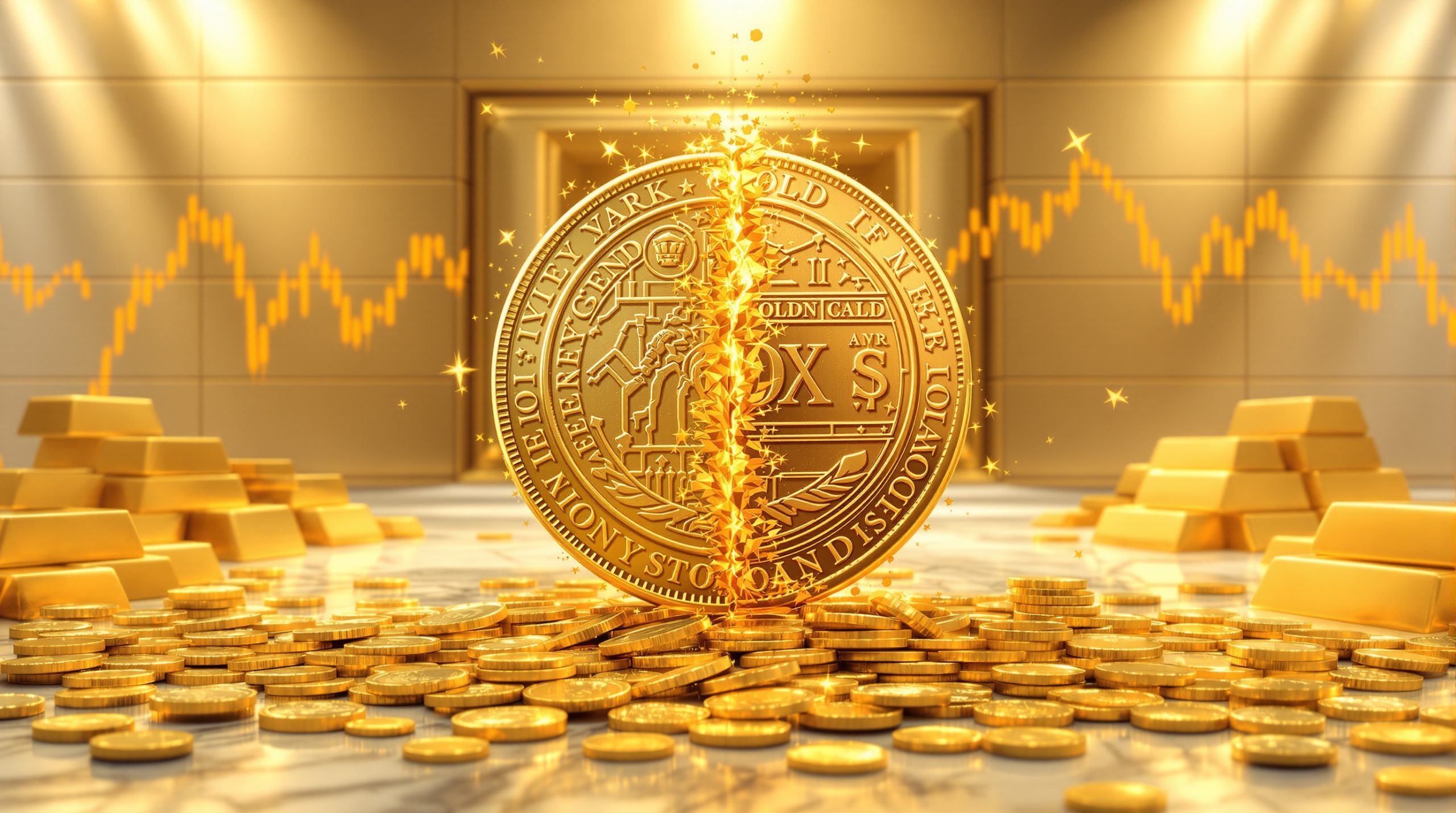Understanding Gold Currency Debasement: Historical Context and Modern Implications
Throughout monetary history, currency debasement has played a significant role, particularly regarding gold and precious metals. This phenomenon, where currencies lose value through excessive money creation or inflation, continues to shape financial markets and investment strategies today. Understanding the relationship between gold currency debasement provides critical insights for investors seeking to preserve wealth in uncertain monetary landscapes.
How Does Currency Debasement Affect Gold Prices?
When a currency loses value—typically through excessive money supply expansion or inflation—gold often appreciates significantly against these debased currencies. This relationship has remained consistent throughout history and continues in today's financial system.
Central bank expansionary policies that increase money supply without corresponding economic growth frequently trigger investor movements toward gold as an inflation hedge. This fundamental relationship explains why gold prices tend to rise during periods of aggressive monetary expansion.
The Monetary Protection Mechanism
Gold's response to currency debasement functions through several important channels:
-
Inflation hedge: As currencies lose purchasing power, gold typically maintains or increases its real value
-
Supply constraint: Unlike fiat currencies created at will, gold's global supply increases by only 1-2% annually
-
Alternative monetary asset: During extreme debasement scenarios, gold can function as an alternative to traditional currencies
-
Psychological security: Market perception of gold as "sound money" drives demand during periods of currency instability
The relationship between gold and currency remains particularly evident during economic crises when trust in traditional monetary systems weakens.
Historical Examples of Gold Currency Debasement
Ancient Roman Debasement
The Roman Empire provides one of history's most instructive lessons in currency debasement. During the 3rd century CE, the silver content in Roman denarii underwent progressive reduction:
| Period | Silver Content | Reduction from Original |
|---|---|---|
| 1st century CE | ~95% | Baseline |
| Mid-2nd century | ~80% | ~15% |
| Early 3rd century | ~50% | ~45% |
| Late 3rd century | <5% | >90% |
This systematic debasement coincided with economic instability and contributed to the empire's eventual decline. Citizens who maintained gold holdings rather than debased denarii successfully preserved their wealth through this turbulent period.
The Great Debasement Under Henry VIII
In 16th century England, King Henry VIII implemented what became known as the "Great Debasement" between 1544 and 1551. Facing financial pressures from military campaigns, the crown systematically reduced precious metal content in coinage:
-
Gold content reduced from 23 karat to as low as 20 karat
-
Silver content decreased from 92.5% sterling silver to approximately 25%
-
Copper introduced as a significant component in "silver" coins
While this debasement generated short-term revenue for the crown, it led to significant price inflation and economic disruption. Individuals who preserved their wealth in high-purity gold coins maintained their purchasing power throughout this period.
Post-WWII Dollar Debasement
The Bretton Woods system established in 1944 linked global currencies to the U.S. dollar, which was convertible to gold at $35 per ounce. However, excessive money creation to fund government spending in the 1960s created an unsustainable situation where dollar claims significantly exceeded U.S. gold reserves.
This imbalance forced President Nixon to suspend dollar-gold convertibility in August 1971, ending the last formal link between major currencies and gold. In the aftermath:
-
Gold prices rose from $35 to over $800 by 1980
-
The dollar's purchasing power declined substantially
-
Investors holding gold during this transition preserved or enhanced their wealth
Financial advisor Greg Orrell explains this historical transition: "In the move in the 70s, gold shot from $35 to $800 and then settled into that $400-$500 range for quite a few years. That move was based on Nixon closing the gold window and the lack of discipline, and that lack of discipline has continued."
Why Do Central Banks Continue to Hold Gold Reserves?
Despite operating in a fiat currency system, central banks worldwide maintain significant gold reserves as a hedge against currency debasement. This practice reveals an important truth: even the institutions responsible for currency management recognize gold's enduring monetary properties.
Central bank gold holdings have increased substantially in recent years:
| Year | Global Central Bank Gold Purchases |
|---|---|
| 2018 | 656 tonnes |
| 2019 | 668 tonnes |
| 2020 | 255 tonnes |
| 2021 | 463 tonnes |
| 2022 | 1,136 tonnes |
| 2023 | 1,037 tonnes |
This trend reflects growing concerns about currency stability and diversification away from dollar-denominated assets. Notable buyers include China, Russia, Turkey, and India—countries seeking to reduce exposure to potential debasement in major reserve currencies.
According to industry experts, central bank demand for gold appears "inelastic"—they continue purchasing regardless of price levels, viewing gold as a long-term stability anchor. This persistent buying provides consistent support for the gold market surge.
The Geopolitical Dimension
Central banks, particularly in Eastern countries, increasingly view gold as an asset that enables trade outside the dollar system. This strategic diversification represents a significant shift in the global monetary landscape.
Russia has publicly announced plans to include silver in future reserves, signaling a potential broadening of monetary metals held by central authorities. Meanwhile, Saudi Arabia has made initial investments in silver-backed exchange-traded funds, suggesting further diversification beyond gold.
How Is Modern Currency Debasement Measured?
Money Supply Growth Metrics
One key indicator of potential currency debasement is rapid expansion of money supply measures:
-
M1: Includes physical currency, demand deposits, and other highly liquid assets
-
M2: Encompasses M1 plus savings deposits, money market securities, and other near-money assets
-
Broad Money: Captures the total money supply within an economy
When these measures grow significantly faster than economic output (GDP), currency debasement typically follows. The relationship between excessive money creation and gold price forecast has been particularly evident since the 2008 financial crisis and the 2020 pandemic response.
Financial analysts track the ratio of money supply growth to economic growth as an early indicator of potential debasement pressures. When this ratio rises sharply, gold often outperforms other asset classes.
Debt-to-GDP Ratios
Rising government debt relative to economic output often precedes currency debasement, as governments may resort to monetary expansion to manage unsustainable debt burdens:
| Country | Debt-to-GDP Ratio (2024) |
|---|---|
| Japan | ~264% |
| Greece | ~188% |
| Italy | ~152% |
| United States | ~123% |
| France | ~112% |
| United Kingdom | ~103% |
Historical analysis shows that gold typically outperforms during periods of rising sovereign debt, as markets anticipate potential currency debasement as a mechanism to manage these obligations.
The relationship between government debt levels and gold prices has strengthened in recent years, with record debt levels correlating with all-time high gold prices across multiple currencies.
Negative Real Interest Rates
When inflation exceeds nominal interest rates, creating negative real rates, currency debasement accelerates as savers lose purchasing power. This environment has historically been highly favorable for gold prices.
Negative real rates effectively tax savings held in traditional currency deposits, encouraging capital flow toward alternative stores of value like gold. This relationship remains one of the strongest correlations in the precious metals market.
Can Gold Protect Against Modern Currency Debasement?
Performance During Recent Debasement Episodes
Gold's performance during recent periods of currency stress demonstrates its continued effectiveness as a hedge against debasement:
-
2008-2011 Financial Crisis Response: Gold rose from approximately $700 to over $1,900 as central banks expanded balance sheets
-
2020-2023 Pandemic Response: Gold reached new all-time highs above $2,000 as unprecedented monetary stimulus was deployed
-
2023-2024 Persistent Inflation Period: Gold surpassed $3,000 as real interest rates remained negative despite nominal rate increases
This consistent pattern of gold appreciation during periods of monetary expansion reinforces its status as a reliable hedge against currency debasement.
Gold vs. Other Anti-Debasement Assets
While gold remains a traditional hedge against currency debasement, other assets compete for this role:
| Asset | Advantages | Limitations |
|---|---|---|
| Gold | Long history, no counterparty risk, universal recognition | Storage costs, no yield |
| Silver | Industrial demand, more affordable unit price | Higher volatility, industrial price influences |
| Bitcoin | Fixed supply, portability, technological innovation | Regulatory uncertainty, relatively short history |
| Real Estate | Tangible asset, potential income, utility value | Less liquid, maintenance costs, location-dependent |
| Inflation-Protected Securities | Direct inflation adjustment, government backing | Still dependent on fiat system, typically low real returns |
The Gold-Silver Relationship
The gold-silver ratio (the amount of silver needed to purchase one ounce of gold) serves as an important metric for precious metals investors. Historically, this ratio has fluctuated significantly:
- During the recording of recent industry interviews, the ratio stood at approximately 81:1
- During periods of monetary stress, this ratio typically contracts
- Industry experts suggest the ratio could potentially move toward 50:1 or 60:1 in the current cycle
Silver's lower price point makes it more accessible as "poor man's gold" when gold prices rise substantially, potentially driving stronger percentage gains in silver during advanced stages of a precious metals bull market.
How Are Governments Responding to Gold's Rise?
The significant appreciation in gold prices has prompted varied responses from governments and monetary authorities:
- Enhanced regulation of gold markets and investment vehicles
- Strategic reserve management with some nations building gold reserves while others consider sales
- Development of central bank digital currencies (CBDCs) as potential alternatives to traditional monetary systems
- Increased reporting requirements for large gold transactions to monitor capital flows
These responses reflect the tension between gold's traditional monetary role and modern fiat currency systems.
Government Shutdowns and Budget Battles
Political instability, particularly around government spending and debt ceiling debates, often triggers short-term gold price movements. However, industry experts caution these represent trading opportunities rather than fundamental shifts in gold's long-term trajectory.
As one precious metals fund manager notes: "Government shutdowns get traders to cover their shorts on a short-term basis, but that's not really what is going to drive the gold market longer term."
The increasing frequency of such fiscal showdowns, however, does reflect the broader debt sustainability challenges facing many governments—a structural issue supporting gold's role as a monetary hedge.
What Does Currency Debasement Mean for Gold's Future?
Expert Projections on Gold Prices
Financial analysts have increasingly revised gold price projections upward in response to ongoing currency debasement concerns:
- Conservative estimates suggest gold could reach $4,000-5,000 within the next 3-5 years
- Moderate projections anticipate potential prices of $5,000-7,000 if current monetary trends continue
- Aggressive forecasts from some analysts suggest $10,000+ gold is possible in scenarios of severe currency instability
These projections reflect growing concerns about the sustainability of current monetary policies and their implications for currency values.
According to industry veteran Greg Orrell: "Gold is going to have these periodic moves where it runs hard and then establishes a new base. Whether that new base is $4,000 to $7,000, that's kind of what we're looking at right now."
Structural Changes in the Gold Market
The response to currency debasement has triggered several important changes in gold markets:
- Repatriation movements: Countries bringing overseas gold reserves back to domestic vaults
- New trading mechanisms: Development of non-dollar gold trading platforms
- Retail investor accessibility: Expansion of gold-backed ETFs and digital gold platforms
- Mining investment: Increased capital allocation to gold production amid higher sustained prices
These changes reflect a growing recognition of gold's role in a world of increasing monetary uncertainty.
The Changing Reserve Currency Landscape
Industry experts observe that while the US dollar remains the world's primary reserve currency, its dominance appears to be weakening—a trend reflected in gold's price appreciation.
As one fund manager explains: "The US won't have the ability that it's abused to finance the way it has been able to finance. We're going to be looking at the US still being a reserve type currency for the foreseeable future, but its position is certainly weakening, and that's what the gold market is telling us."
How Can Investors Position for Currency Debasement?
Portfolio Allocation Strategies
Financial advisors increasingly recommend gold exposure as protection against currency debasement:
- Conservative allocation: 5-10% of investment portfolio
- Moderate allocation: 10-20% during periods of heightened monetary uncertainty
- Aggressive allocation: 20-30% for investors with strong currency debasement concerns
According to industry experts, even a modest allocation to gold can significantly improve portfolio performance over time: "If you had a 10% plus position in gold, you've done very well over time."
Gold Investment Vehicles
Investors can access gold through multiple channels, each with distinct characteristics:
| Investment Type | Advantages | Considerations |
|---|---|---|
| Physical bullion | Direct ownership, no counterparty risk | Storage, insurance, potential premium over spot |
| Gold ETFs | Liquidity, ease of trading, low transaction costs | Counterparty risk, annual fees |
| Gold mining stocks | Operational leverage to gold price, potential dividends | Company-specific risks, market volatility |
| Gold royalty companies | Exposure without direct mining risks, dividend potential | Premium valuations, indirect exposure |
| Gold futures/options | Leverage, sophisticated strategies | Complexity, expiration dates, margin requirements |
Mining Company Selection Criteria
For investors considering gold mining stocks, industry experts recommend examining several critical factors:
- Jurisdiction quality: The regulatory environment and permitting timeline significantly impact project viability
- Management expertise: "Men make mines"—the experience and track record of leadership remains crucial
- Development timeline: Quality mining projects typically require 7-10 years from discovery to production
- Cut-off grade discipline: Companies that maintain disciplined mining approaches rather than continually lowering grade standards
- Per-share metrics: Focus on companies demonstrating growth in gold production and reserves on a per-share basis rather than diluting shareholders
One industry veteran cautions against companies that pursue "profitless prosperity" by lowering cut-off grades to extend mine life without generating meaningful returns for shareholders, even at higher gold prices.
The Importance of Margin Discipline
Mining industry experts emphasize that gold mining companies should focus on maintaining profit margins rather than simply extending production at lower grades:
"My pet peeve is when miners say 'we want to prolong the life of a mine' but get into profitless prosperity running the mine for the employees so it lasts longer. The mine was designed for leverage to the gold market. Investors get into gold mines because if gold was $1,000 and goes to $1,500—that's a 50% move—that's the leverage investors want."
This discipline separates quality mining investments from those that will underperform even in rising gold price environments.
Conclusion: Gold's Enduring Role in Monetary Systems
The relationship between gold and currency debasement remains as relevant today as throughout monetary history. While modern financial systems have evolved beyond the gold standard, the fundamental dynamics that drive investors to gold during periods of currency stress persist.
As governments and central banks navigate complex economic challenges, gold continues to serve as both a barometer of monetary confidence and a refuge from currency debasement. Understanding this relationship provides valuable context for investors, policymakers, and anyone seeking to preserve wealth in an uncertain monetary landscape.
Whether as a portfolio allocation, a monetary system component, or simply a store of value, gold's role in responding to currency debasement represents one of the most enduring financial relationships in economic history.
Key Takeaways
- Currency debasement has occurred throughout history, from ancient Rome to modern monetary systems
- Gold has consistently preserved purchasing power during periods of currency debasement
- Central banks continue accumulating gold reserves despite operating in a fiat currency system
- Modern debasement can be measured through money supply growth, debt levels, and negative real interest rates
- Portfolio allocation to gold provides investors with a historically effective gold investment strategies against currency debasement
- The fundamental relationship between gold and currency debasement remains intact despite changing financial systems
As one industry veteran summarizes: "An ounce of gold is an ounce of gold. It's really the dollar that's going up and down versus gold."
Looking for the Next Major Mining Discovery?
Stay ahead of the market with Discovery Alert's proprietary Discovery IQ model, which instantly identifies significant ASX mineral discoveries and turns complex data into actionable insights for investors. Explore why historic discoveries can generate substantial returns by visiting Discovery Alert's dedicated discoveries page and begin your 30-day free trial today.




